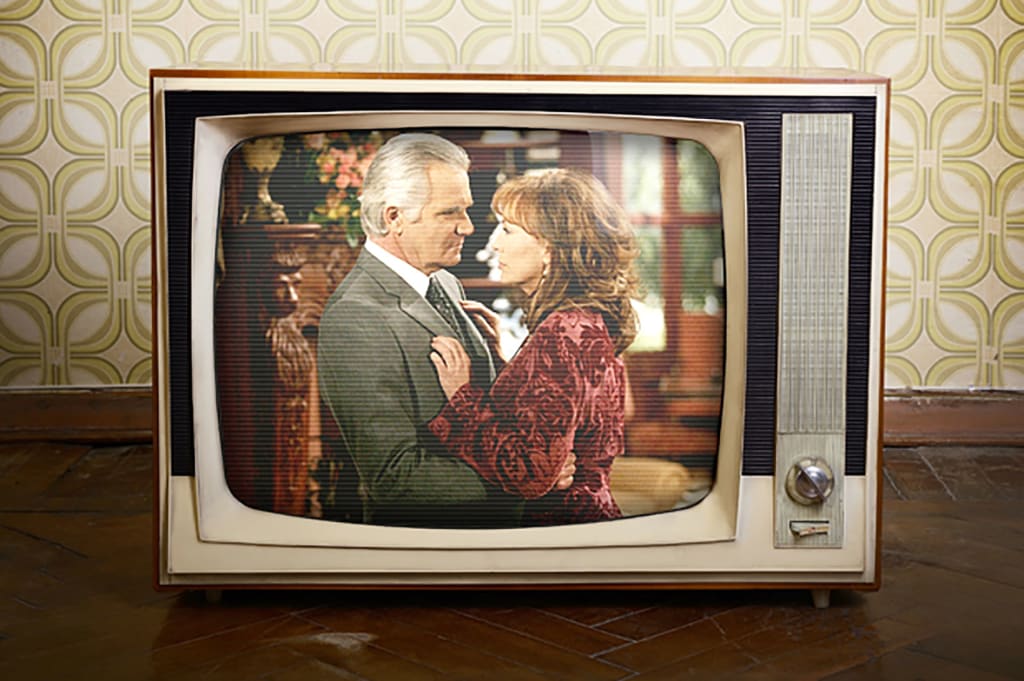History of Drugs in Soap Operas
Drugs and soap opera have equal users to viewers.

Soap operas and drugs have more in common than most people would imagine. For one thing, they both can be addictive and have equal viewers to users. For another, the soaps pioneered the subject of drugs in their shows. Conservative housewives who watched the original soaps have witnessed in recent years, between tear jerks: people slipping pills in other people's drinks as if they were ice cubes; accidental (and not so accidental) drug trips, drug dealers, deaths by overdose, cocaine addictions, drug treatment centers, stolen prescriptions, and more, much more, as the world turns.
Why were the soaps so drugged? Largely because they were melodramas, and being such, they had to have a constant flow of dramatic events. Drug deaths, murders, OD's and addictions are all inherently dramatic, especially if they're blown out of proportion. Also, soaps had so much time in which to explore the terrain. This was long before homosexuality became fodder for melodramatic narratives.
Still, the dramatic aspect of drugs can't be underestimated. Throughout the history of soaps, one finds numerous instances of drug use. There was an awful lot of pot, perhaps because in the late 20th century, this hit too close to home for those moms with teenage kids. There has been a moderate amount of LSD-good for making characters do things they'd never normally do-and more than a little cocaine, not to mention enough ups, downs and inbetweens to fill several rehab facilities in Malibu. Hard drugs obviously have the greatest dramatic impact, and they were often used when a quick emotional response was needed.
One of the first examples of drugs on the soaps was a typical one for the time. A character named Lee Randolph on An Other World found herself tripping, when she sipped coffee that a thug called Lefty had mischievously dropped a hit of acid into. She found out soon enough, and, panic-stricken, she did some intense research about the effects of acid on chromosomes, concluding that she'd never be able to have children again. Accordingly, she threw Sam Lucas (the man she loved) out of the house, thereby ruining her life, or whatever remained of it (she got knocked off during one of her drug-induced hallucinations).
Character did not take drugs of their own volition.

Rather than the character taking drugs of her own volition, Lee Randolph is slipped them by a bad guy. Rather than reacting the way most people would to a trippy experience, she panics and overreacts. But you have to remember who the audience was, daytime TV.
Perhaps, but the same cannot be said for the vagueness and innuendo that often followed drugged characters around on the soaps. A couple of characters, one on Somerset and one on One Life TO Live, always looked stoned, but the writers never came out and said it.
Cloudiness, indirectness, ignorance they all were implied symptons of drug use on the soaps, maybe because the shows were aimed at a particularly naive audience in the 1970s. The characters that take them are ignorant-Lee Randolph, for example, or Jacklyn Zeman's Lana McClain on One Life to Live, who mixed drinks and pills to terminal effect. Also, the writers themselves often seemed ignorant of the subject, or at least they distort what they do know in order to make their overwrought dramas move. In The Young and the Restless, one plot line had the catatonic, mentally disturbed Nancy Becker, played by Cathy Carricaburu, suddenly come to life after being given a few pills by her husband. Back then, the women was always supplied by a man. Nancy's was a miraculous transformation. No wonder it was considered a landmark, then, when One Life To Live, treated the subject of drug abuse realistically and vividly in 1971. This was one of the clearest instances of soaps putting prime time to shame in the categories of topicality and directness. Cathy Craig, played by Amy Levitt, was a naughty 18-year old girl who rebelled against her stepmother and began to take diet pills, which led to amphetamines, which then led to LSD. She stole a prescription pad from her father, Dr. Jim Craig. Soon enough, Cathy was hooked on drugs.
Cathy Craig talked with real drug patients.

Rather than just do the conventional drug addiction plot, writer/creator Agnes Nixon decided she had to do something extra to make contact with young people home from school for the summer months. She had cameras go to the real life Odyssey House drug treatment center and film Craig/Levitt talking with real drug patients who discussed their own real addictions with great dramatic impact. The resulting blend of fact and fiction was revolutionary for TV, as well as being the first time the medium heeded the White House's advice that it convey narcotics abuse warnings. The soap's viewers heard real inmates say things like, "I'm not going to take any more drugs" ("Yeah," another answered, "I said The same thing a million times”) and "Cathy, it's not a weakness to ask for help." The audience had its mind blown, to say the least.
Cathy was cured, naturally, and became a reporter for the Lanview Banner, writing a nationally syndicated article about what to do when you contract VD. She also wrote a book of short stories, which won feminist acclaim. And while she was made to fall in love with a blue eyed, blonde, all-American type, diverting attention from the ghetto kids, the impact of the drug segments was still inarguable.
Reportedly, ratings went up slightly during the period of the drug plot line, probably because the real-life footage was so compelling. Ratings actually went down when other soaps showed less realistic drug sequences. The generally held consensus, though, was that drugs may up the ratings for a while, but not in the long run. This was long before Broad City and High Maintenance.
In the case of One Life To Live, it didn't hurt that the subject was presented with an inherent warning: Look at Cathy thrown in with all these unsavory minorities, playing on 1970s inherent racist stereotypical inmates. Drugs were never presented as an occasional and tolerable self-indulgence, but only as a serious and disturbing problem, one that inevitably brought a terrible retribution.
Soaps tried to handle drugs realistically.

The built-in message made the stories acceptable to apprehensive parents and not too encouraging to youngsters who were watching more and more. Soaps tried to handle drugs realistically, but they always tried to show it in a negative way. If a character ever advocated drugs, he came to a bad end.
Case in point: Eileen Siegal on One Life To Live a housewife who became hooked on speed and very nearly died, or Claudette Montgomery, a character on All My Children who was sent to prison for cocaine possession for two whole years. She then resurfaced, almost fully repentant, in the guise of a whole other actress. Obviously, her experience had really changed her.
Eventually drugs became less prevalent.

Drugs became less prevalent than they were when they first broke on the Soaps in the 1970s. Counter culture became pop culture, lessons were no longer taught and everyone knew someone who was touched by drugs in life.
It took Norman Lear's soap satire, Mary Hartman, Mary Hartman, to point up all the inanities of drug use on the soaps. Remember when Mary's neighbor, Lenny, under the influence of alcohol and barbiturates, drowned in a bowl of Mary's chicken soup? Yes, that happened. Or when Mary found a joint on Heather, and after a moment of apprehension, ended up sharing it with Tom. At least soap operas were not afraid to deal with the realities facing their audience. Perhaps this attitude has made the iconic genre, one of the longest lasting in the history of television.
About the Creator
Potent Staff
A serious group of marijuana connoisseurs always giving back to the community. Peace.






Comments
There are no comments for this story
Be the first to respond and start the conversation.